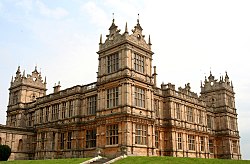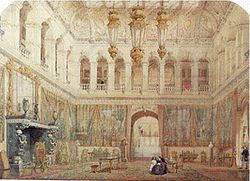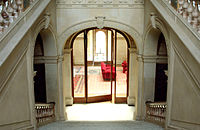Mentmore Towers: Difference between revisions
| Line 40: | Line 40: | ||
[[File:Mentmore-explodingJpeg.jpg|left|thumb|200px|The ground floor. 1:Grand Hall; 2:White Drawing Room; 3:Dining Room; 4:Library; 5:Amber Room; 6:Vitreous enamel|limoges Room; 7:Imperial staircase; 8:Study; 9:Vestibule; 10:Green drawing Room; 11:South Entrance Hall; 12:Blarenberghe Room; 13:du Barry Room; 14:Billiards Room; 15:Smoking Room/Armoury; 33: Italian garden; 34:Servants' courtyard; 35:Cour d'honneur; 36:South Terrace; ST:minor service staircases]] | [[File:Mentmore-explodingJpeg.jpg|left|thumb|200px|The ground floor. 1:Grand Hall; 2:White Drawing Room; 3:Dining Room; 4:Library; 5:Amber Room; 6:Vitreous enamel|limoges Room; 7:Imperial staircase; 8:Study; 9:Vestibule; 10:Green drawing Room; 11:South Entrance Hall; 12:Blarenberghe Room; 13:du Barry Room; 14:Billiards Room; 15:Smoking Room/Armoury; 33: Italian garden; 34:Servants' courtyard; 35:Cour d'honneur; 36:South Terrace; ST:minor service staircases]] | ||
[[File:Mentmore Tower grand staircase.jpg|left|thumb|200px|The grand staircase]] | [[File:Mentmore Tower grand staircase.jpg|left|thumb|200px|The grand staircase]] | ||
The house was built between 1852 and 1854 for Baron Mayer de Rothschild, who required a house close to London. Paxton, who had previously designed the Crystal Palace, was responsible for the ridge and furrow glass roof which covered the central hall, designed to imitate the arcaded courtyard of a Renaissance palazzo, while Stokes was co-architect and clerk of works.<ref>Hall (Waddesdon Manor), p37.</ref><ref>The Builder Magazine 1852.</ref><ref>Hall (The Victorian Country House), p153, names Stokes and Paxton as joint architects.</ref> The builder was the London firm George Myers, frequently employed by members of the Rothschild family.<ref>Hall (The Victorian Country House), p16.</ref> | The house was built between 1852 and 1854 for Baron Mayer de Rothschild, who required a house close to London. Paxton, who had previously designed [[the Crystal Palace]], was responsible for the ridge and furrow glass roof which covered the central hall, designed to imitate the arcaded courtyard of a Renaissance palazzo, while Stokes was co-architect and clerk of works.<ref>Hall (Waddesdon Manor), p37.</ref><ref>The Builder Magazine 1852.</ref><ref>Hall (The Victorian Country House), p153, names Stokes and Paxton as joint architects.</ref> The builder was the London firm George Myers, frequently employed by members of the Rothschild family.<ref>Hall (The Victorian Country House), p16.</ref> | ||
==Earls of Rosebery== | ==Earls of Rosebery== | ||
Latest revision as of 12:22, 23 June 2018
| Mentmore Towers | |
| Buckinghamshire | |
|---|---|
 Mentmore Towers | |
| Location | |
| Village: | Mentmore |
| History | |
| Built 1852-1854 | |
| Country house | |
| Information | |
Mentmore Towers is a 19th-century country house in the village of Mentmore in Buckinghamshire. The house was built for the banker and collector of fine art Baron Mayer de Rothschild as a country home, display case for his collection of fine art. It was designed by Joseph Paxton and his son-in-law, George Henry Stokes,[1][2] in the 19th-century revival of late 16th and early 17th-century Elizabethan and Jacobean styles called Jacobethan[3][4]
The mansion has been described as one of the greatest houses of the Victorian era.[5][6] In keeping with the contents intended to be displayed within, the interiors take their inspiration principally from the Italian Renaissance, although the house also contains drawing rooms and cabinets decorated in the gilded styles of late 18th-century France.[7] Historically it was first known simply as 'Mentmore'. The design is closely based on that of Robert Smythson's Wollaton Hall.[8]
Mentmore Towers is a Grade I listed building, with its park and gardens listed Grade II*.[9]
Mentmore was the first of what was to become a virtual Rothschild enclave in the Vale of Aylesbury, as later, other members of the family built houses at Tring in Hertfordshire, Ascott, Aston Clinton, Waddesdon and Halton.[10] Since 1846 Baron Mayer de Rothschild had been buying land in the area.[11]
Architecture



The house was built between 1852 and 1854 for Baron Mayer de Rothschild, who required a house close to London. Paxton, who had previously designed the Crystal Palace, was responsible for the ridge and furrow glass roof which covered the central hall, designed to imitate the arcaded courtyard of a Renaissance palazzo, while Stokes was co-architect and clerk of works.[12][13][14] The builder was the London firm George Myers, frequently employed by members of the Rothschild family.[15]
Earls of Rosebery
Baron Mayer de Rothschild and his wife did not live long after the Towers' completion. After the Baroness's death it was inherited by her daughter Hannah, later Countess of Rosebery.[16] Following her death from Bright's Disease in 1890 at age 39, the house became the home of her widower Archibald Philip Primrose, 5th Earl of Rosebery, later Prime Minister for two years from 1894.[16] In the late 1920s, the fifth earl gave the estate to his son Harry, Lord Dalmeny, who in 1929 on the death of his father, became the sixth Earl.[16]
Both earls bred numerous winners of classic horse races at the two stud farms on the estate, including five Epsom Derby winners. Both stud farms were within a mile of the mansion and together with the stable yard were designed by the architect George Devey, who also designed many cottages in the estate's villages of Mentmore, Crafton and Ledburn.[11]
Second World War
The wife of the sixth Earl, Eva, was interested in the arts and was acquainted with Kenneth Clark and other national art museum directors.[17] As a result of Lady Rosebery's friendships, Mentmore was chosen by the British government to store part of the British national art collections during the Second World War.[17] The collections of the National Portrait Gallery were subsequently stored at Mentmore for the duration of the war, along with pieces from the Royal Collection, including the Gold State Coach.[17] The paintings were given temporary frames during the war.[17] Further works transferred to Mentmore included the portraits from Speaker's House in the Palace of Westminster, and tapestries, furniture and Grinling Gibbons carvings from Hampton Court Palace.[17]
The collection was stored in the 'battery room' subsequently nicknamed the 'refuge', part of the 'gas house', a group of outbuildings where gas and electric light were supplied for the estate.[17] Four men guarded the refuge at night, and two during the day.[17]
Sale and dispersal
The possible purchase of Mentmore for the nation through the government's National Land Fund was the desire of Roy Strong, the Director of the V&A, who hoped that Mentmore would become a 'branch' of his museum for 19th-century decorative arts as Ham House was for the 17th-century and Osterley was for the 18th-century.[18] The government refused to spend such large sums from the fund, and the sale fell through.[18]
Following the death of the sixth earl in 1973, the Labour government of James Callaghan refused to accept the contents in lieu of inheritance taxes, which could have turned the house into one of Britain's finest museums of European furniture, objets d'art and Victorian era architecture. The government was offered the house and contents for £2,000,000 but declined, and after three years of fruitless discussion, the executors of the estate sold the contents by public auction for over £6,000,000. Among the paintings sold were works by Gainsborough, Reynolds, Boucher, Drouais, Moroni and other well known artists, and cabinet makers, including Jean Henri Riesener and Chippendale. Also represented were the finest German and Russian silver- and goldsmiths, and makers of Limoges enamel. This Rothschild/Mentmore collection is said to have been one of the finest ever to be assembled in private hands, other than the collections of the Russian and British royal families.[19] The sale of Mentmore has been described as a 'turning point for the preservation movement'.[20]
Many items were removed from Mentmore by the Roseberys and taken to their residence at Dalmeny House, near Edinburgh.[21] Items from Mentmore at Dalmeny include tapestries, Sèvres porcelain, and an equestrian statue by Joseph Boehm of 'King Tom', the foundation stallion for Baron Mayer de Rothschild's Mentmore and Crafton Studs.[21]
Maharishi Foundation
In 1978 Mentmore became the headquarters for Maharishi Mahesh Yogi's educational charity, the Maharishi Foundation, in 1978.[22] The building was put up for sale in 1997 but did not change owners until 1999 when it was purchased by investor Simon Halabi.[23]
Simon Halabi
Under the ownership of Halabi the house was renamed Mentmore Towers Ltd with the intention of converting it into a luxury hotel with 171 suites, including 122 in a new wing on the slope below the house.[24] This was delayed by a judicial review of the planning permission launched by a local resident, and though this challenge was defeated, the conversion project stalled after the property price crash. The intention had been that Mentmore and the old In & Out Club in London would operated together as Europe's first 'six-star' hotels, one located in town and the other to be the country sister.
After this, the house was to decline. English Heritage placed it on the "At Risk register" noting that the house needs urgent work on the roof and chimneys: weather could penetrate to the interiors, considered among the finest examples of Victorian design and craftsmanship in Britain.
The latest proposal after the In & Out Club was sold separately,is to renovate the original Mentmore Towers building and not construct the new extension containing guest-room suites, conference facilities and a large spa.
Golf courses
Much of the historic park[25] was sold off in 1944[26] and reverted to agricultural use before becoming the Mentmore Golf and Country Club, established in 1992, which has two eighteen hole golf courses, the Rothschild Course and the Rosebery Course. Although in the same ownership, Mentmore Towers and its grounds and Mentmore Golf and Country Club are quite separate.
Film location
The house has appeared in many films, including:
- Brazil (Terry Gilliam, 1985)
- Slipstream (1989)
- Eyes Wide Shut (1999 Stanley Kubrick)
- Quills (2000)
- The Mummy Returns (2001)
- Ali G Indahouse (2002)
- Johnny English (2003)
- Batman Begins (2005), where it was used as the gothic Wayne Manor.[27]
In 1982 director Howard Guard filmed the Roxy Music video to "Avalon" at the house. It also served as the filming location of Enya's Dan Nathan-directed "Only If ..." (1997) and the Spice Girls Howard Greenhalgh-directed "Goodbye" (1998) music videos. It was also featured as the location of the rave party in the Inspector Morse's episode Cherubim and Seraphim.[28]
Outside links
| ("Wikimedia Commons" has material about Mentmore Towers) |
References
- ↑ Hall, p16.
- ↑ Hall (Waddesdon Manor), p31, refers to them as the architectural team.
- ↑ Henry Russell Hitchcock (1958) Architecture: Nineteenth and Twentieth Centuries (Pelican History of Art), London, Penguin Books, p.73
- ↑ IoE|42105|Mentmore House}}
- ↑ Hall (Waddesdon Manor), p37, makes this assertion
- ↑ Hall (The Victorian Country House, p153
- ↑ Crewe, Vol, p116
- ↑ Mark Girouard, The Victorian Country House, Yale 1978
- ↑ National Heritage List 1000319: Mentmore Towers
- ↑ Cowles, Virginia (1975). The Rothschilds, a family of fortune. London: First Futura Publications. ISBN 08600 7206 1.
- ↑ 11.0 11.1 Binney, Marcus. John Robinson. William Allan (1977). SAVE Mentmore for the Nation. London: SAVE Britain's Heritage.
- ↑ Hall (Waddesdon Manor), p37.
- ↑ The Builder Magazine 1852.
- ↑ Hall (The Victorian Country House), p153, names Stokes and Paxton as joint architects.
- ↑ Hall (The Victorian Country House), p16.
- ↑ 16.0 16.1 16.2 McKinstry, Leo (2005). Rosebery, a statesman in turmoil. London: John Murray (publishers). ISBN 0-7195-6586-3.
- ↑ 17.0 17.1 17.2 17.3 17.4 17.5 17.6 Martin-Robinson 2014, pp. 128 Cite error: Invalid
<ref>tag; name "Martin-Robinson2014" defined multiple times with different content - ↑ 18.0 18.1 Peter Mandler (1 May 1999). The Fall and Rise of the Stately Home. Yale University Press. pp. 472–. ISBN 978-0-300-07869-5. http://books.google.com/books?id=wQfqCc0gxAoC&pg=PA472.
- ↑ Sotheby's (1977). Mentmore Volume I -V. London: Sotheby, Parke, Bernet & Co.
- ↑ Nigel R. Jones (1 January 2005). Architecture of England, Scotland, and Wales. Greenwood Publishing Group. pp. 296–. ISBN 978-0-313-31850-4. http://books.google.com/books?id=epsFOeV1mCMC&pg=PA296.
- ↑ 21.0 21.1 Hugh Montgomery-Massingberd; Christopher Simon Sykes (1 January 1997). Great Houses of Scotland. Laurence King Publishing. pp. 93–. ISBN 978-1-85669-106-2. http://books.google.com/books?id=yp0quIr2xH8C&pg=PA93. Cite error: Invalid
<ref>tag; name "Montgomery-MassingberdSykes1997" defined multiple times with different content - ↑ Jury, Louise (13 May 1997). "Stately home for sale: could suit yogic flyer or maharishi". The Independent.
- ↑ Unknown author (12 November 2000). "Revealed: Buyer of the In and Out Club". Sunday Business.
- ↑ EPR Architects, Mentmore Towers – accessed 22 September 2006.
- ↑ Mentmore Towers English Heritage
- ↑ Mentmore Towers Di Camillo Companion
- ↑ Dark Knight Location Guide. Empire Online. Retrieved 23 July 2012.
- ↑ http://www.dicamillocompanion.com/houses_detail.asp?ID=1365 Di Camillo Film Companion]
- Hall, Michael (2002). Waddesdon Manor. new York: Harry N Abrams. ISBN 0-8109-3239-3.
- Crewe, Marquess of (1931). Lord Rosebery. London: John Murray.
- Hall, Michael (2009). The Victorian Country House, from the archives of Country Life. London: Aurum Press. ISBN 978-1-84513-457-0.
- Martin-Robinson, John (2014). Requisitioned: The British Country House in the Second World War. London: Arum. ISBN 978-1-781-31095-3.
